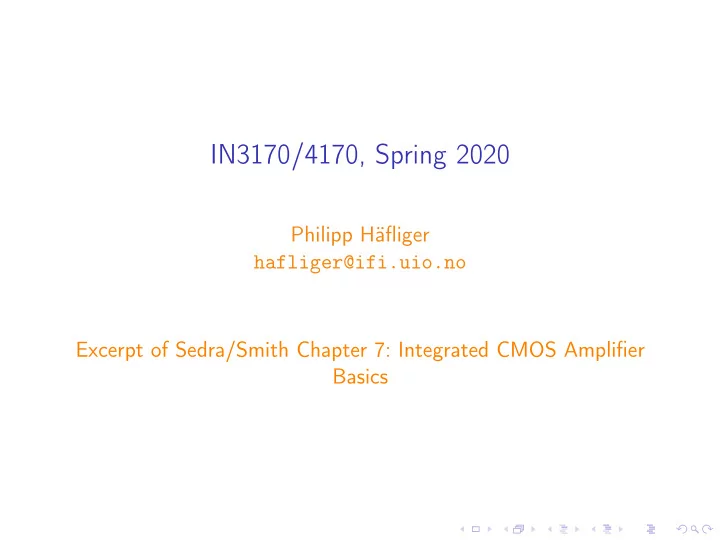

IN3170/4170, Spring 2020 Philipp Häfliger hafliger@ifi.uio.no Excerpt of Sedra/Smith Chapter 7: Integrated CMOS Amplifier Basics
Content CG, and Cascode Configuration (book 7.4-7.5) Common Drain Stage/Source Follower (Book 6.3)
CMOS Current Steering
Computing R ref CMOS Current Steering (live on whitebord) Wrong: using the small signal input resistance 1 g m for a desired I D Correct: Use large signal model!!!
Dynamic Input Currents, Current Amplifier
Content CG, and Cascode Configuration (book 7.4-7.5) Common Drain Stage/Source Follower (Book 6.3)
CG amplifier
R in of a CG amplifier v x = ( i x + g m v gs ) r o + i x R L ⇒ R in ≈ 1 + R L ( 7 . 54 ) g m g m r o
R out of a CG amplifier v x = ( i x − g m v gs ) r o + i x R S ⇒ R out ≈ r o + ( g m r o ) R s ( 7 . 58 )
Cascode Amplifier Can be looked upon as a CS and CG in series resulting in a intrinsic combined gain A = g m 1 r o 1 g m 2 r o 2 (i.e. with a large load resistance), or a circuit where the CS serves as high quality voltage controlled current source delivering i d ≈ g m 1 v i and the CG buffers that current to a high output resistance ≈ g m 2 r o 2 r o 1 .
Cascode Amplifier with Infinite Load Resistance
Cascode Amplifier with Finite Load Resistance (1/2) The load R L must be of equal magnitude as R O to get the benefit of the increased gain A V ! So here with a simple pFET we are back to square one.
Cascode Amplifier with Finite Load Resistance (2/2) Better: employ a cascoded current source.
Dependency of Gain on R L
Content CG, and Cascode Configuration (book 7.4-7.5) Common Drain Stage/Source Follower (Book 6.3)
Common Drain Amplifier/Source Follower
Common Drain Amplifier/Source Follower R L A = 1 R L + g m R O = 1 g m
Recommend
More recommend